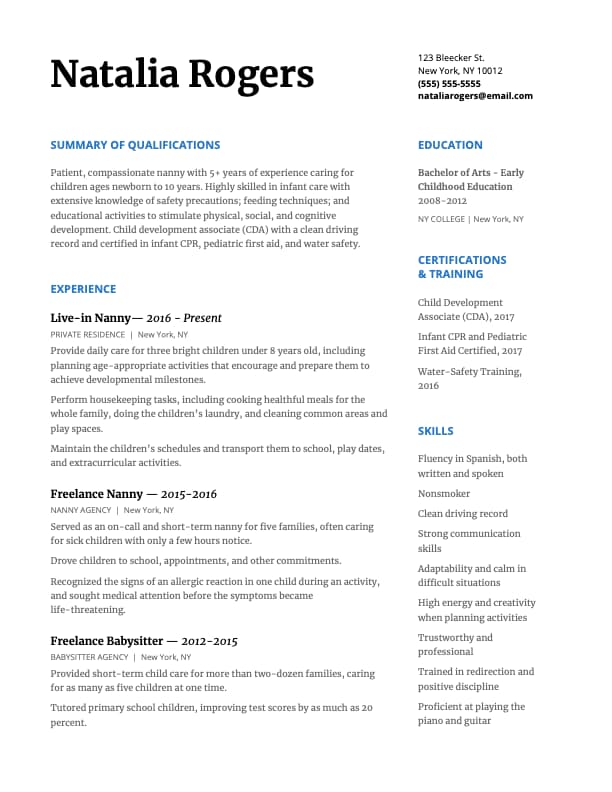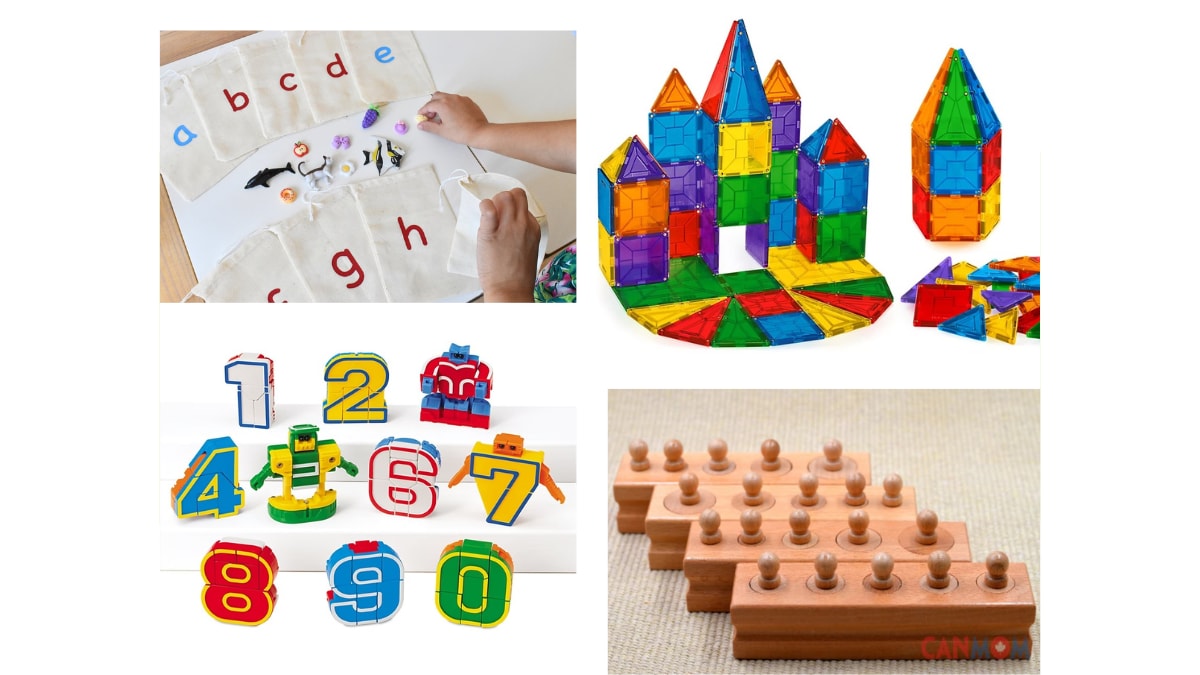As you’re searching for the right nanny job, it’s important to make yourself stand out from the crowd. And nothing helps you make a great first impression on a family more than having an outstanding nanny resume. What you’ll include on your nanny resume will depend a lot on what the family is looking for, but in general, there are a few things you’ll want to include regardless of the position.
Here, a sample nanny resume and read details on each section.
Sample nanny resume

(Click here to download this nanny resume template as a PDF.)
Contact information
It seems obvious, but worth pointing out, that having your contact information on your nanny resume is the easiest way for families to follow up with you. Include it at the top of every individual page of your resume along with any websites you’d like the family to visit to find out more about you. This can be your social media accounts, personal websites or other relevant online profiles, like those on Care.com.
What to include:
- First and last name.
- Mailing address.
- Cell phone number.
- Email address.
Summary statement
Also referred to as a “Summary of Qualifications,” a summary statement gives you the opportunity to briefly explain why you’re the best fit for the job. Keep in mind that families could be going over dozens of resumes and may be skimming the first few lines to weed out applicants who aren’t qualified. By telling them right away why you’re a good fit, you’ll increase the chance that they’ll read your nanny resume all the way through.
What to include:
- Three to four sentences in a bulleted list or paragraph form that summarize the most important details of your past experience, skills or certifications. Your summary statement should be tailored to the job description. For example, if you’re applying to a job caring for an infant, you should highlight that you’re certified in infant CPR.
- One to two specific accomplishments that might set you apart from other comparably qualified candidates.
Past nanny, babysitting and child care experience
This section of your nanny resume should build on your summary statement. You should show how your past experiences have prepared you for the position you’re applying for now. You don’t have to mention every detail about your past nanny jobs, but include the aspects of previous positions that will overlap with the family’s job description.
What to include:
- Who you worked for and where the position was located.
- What position(s) you held and when — a simple month/year note is fine (ex. Jan. 2010 – June 2012).
- The relevant job duties for each position and your major accomplishments — use a bulleted list and strong action verbs to begin each description.
Don’t limit your work history to only full-time caregiving experiences. Any previous child care experience can be included, as long as it relates to the job you’re applying for. For example, if you took a break in your work history to care for your children, that time period is often viewed positively and relevant for a nanny position.
Finally, be specific and descriptive and show measurable progress whenever you can. Mention how your teaching helped improve a child’s ability to count, spell or increase their vocabulary. Or if you’ll be required to meal prep, describe your experience cooking well-balanced and nutritious food.
Educational background
Not all nanny positions require a degree, but if you have an associate’s degree or higher, it could help set you apart from other applicants by showing advanced training and/or relevant coursework that has prepared you for this specific job. Similarly, if you are currently enrolled and have plans to graduate, you can include your degree along with your expected graduation date (ex. Early Childhood Education, Expected Graduation Date May 2020).
What to include:
- Name of the school(s) you attended.
- Years you attended and when you graduated.
- Degree(s) achieved.
Where you place this section will depend on how much experience you have and the level of degree you’ve earned. Generally speaking, experience matters more to parents than degrees. So if you have a lot of work experience (more than five years), you should place that section first. However, if you have a particularly impressive degree but not much experience, you might consider placing the education section before experience.
Certifications and training
Like education, highlighting your certifications and specialized training can help give you a leg up on the competition. Many nanny positions, for example, stipulate that applicants must be certified in CPR and pediatric first aid. Others might give preference to those who have obtained the Child Development Association (CDA) credential for early childhood education.
Even if the job listing doesn’t specifically call out certifications, it might still be a good idea to mention any training you have that could prove useful in your role as a nanny, such as a water-safety course.
What to include:
- Training course and the date it was completed.
- Certification course and the date it was obtained and/or will expire (if applicable).
Skills that qualify you for a nanny job
Creating a separate section to highlight skills is another way you can show families at a glance that you are the right person for the position. You should list a combination of “hard” skills that are fairly easy to quantify, and “soft” skills that are slightly more intangible but nonetheless important.
Examples of nanny skills
|
Hard skills |
Soft skills |
|
Fluent in Spanish, both written and spoken Meal-planning Experience in housekeeping tasks Reading music Computer programs (Word, Excel, etc.) Clean driving record Nonsmoker Playing piano |
Multitasking Time management Positive discipline Creative problem-solver Patience/compassion Conflict resolution High energy Flexibility/adaptability |
Other tips for writing a nanny resume
Proofread
Be sure to read and reread your resume several times to catch any typos or inaccuracies. Keep a particular eye out for incorrect word usage that might not be caught by spell-checking software (ex. it’s vs. its). Go as far as to send your resume to a friend so a fresh set of eyes can catch mistakes you may have glossed over. Even small errors in your resume reflect negatively on your attention to detail and can keep families from reaching out to you for an interview.
Be honest
Caring for someone else’s child is a monumental responsibility and one that requires a lot of trust. Fudging facts or including skills or experiences you don’t actually have will eventually be discovered by the family. You don’t have to be overly modest, but be prepared to support and elaborate on everything you put in your resume with a demonstration or example.
Don’t go overboard with designs or color schemes.
While a well-designed resume can help grab the eye of the person reviewing it and set you apart from the other applicants, cutesy fonts or clip art can backfire by making you look amateur and unprofessional. A resume should look neat and clean, but most importantly, it should be readable. Use an easy-to-read font and create headers for each section to make them simple to find at a glance. Many programs have formatted templates you can use to build your nanny resume that are both attractive and legible.






